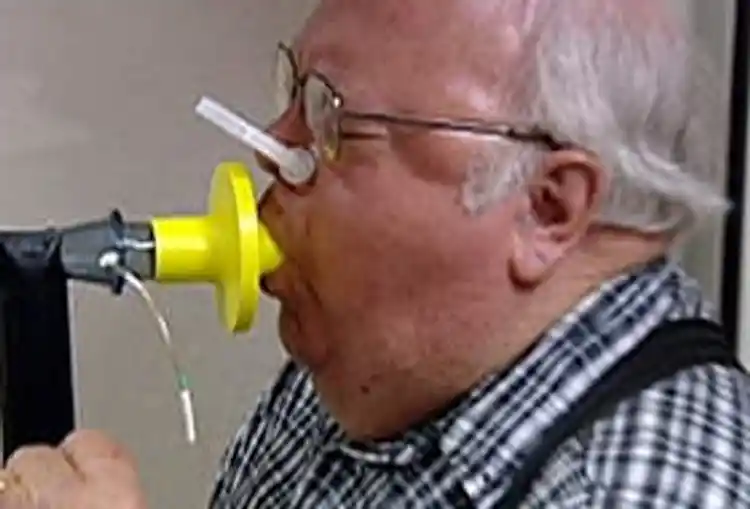Diagnosing COPD

Hide Video Transcript
Video Transcript
Nurse
Take a big deep breath in, up, up, up, up! Suck it in – blow hard! Blast out fast! Blow it out, blow it out, blow it out, blow, blow, blow. Breathe deep, up, up, up, up and catch your breath Narrator
Ed King is working hard to find out how well his lungs are functioning. Nurse
Let's do that again. Same thing. Narrator
He's doing a lung function test called Spirometry. Ed suffers from COPD – Chronic Obstructive Pulmonary Disease. It's progressive…getting worse over time and there's no cure. Ed King
You might have an easy day of breathing. The next day you get up, you may not have an easy day of breathing. Nurse
Breathe deep, up, up, up, up and let it go. Narrator
In patients like Ed…doctors follow disease progression and sometimes make treatment changes. Spirometry is an important tool in both monitoring and diagnosing COPD. David Schulman, MD, MPH
And with that we measure two things. The amount of air they can move in and out of their lungs and the speed with which they do it. Nurse
Blow HARD! Blast out fast. Narrator
Patients are asked to forcefully blow out as much air as they can in one second. That speed is referred to as FEV1 – or Forced Expiratory Volume in 1 second. David Schulman, MD, MPH
One of the early signs of COPD is obstruction, is the inability to move air out as quickly as you normally should be able to do. FEV1 is a marker of obstruction Nurse
Now take a BIG breath in. Narrator
The other measure is referred to as FVC – or Forced Vital Capacity. Narrator
After a huge inhalation, the amount of air that can be forcibly breathed out is measured. Nurse
Just a little further, all the way empty, all the way out…and take a big full breath in, up, up, up, up and catch your breath David Schulman, MD, MPH
The ratio between FEV1 and Forced Vital Capacity is the data point we use to determine whether you have obstructive disease or not. Narrator
About half of those with COPD don't know it…even though they may have symptoms such as shortness of breath, ongoing cough, wheezing or chest tightness. Narrator
That's why screening may be suggested if you're a current or former smoker over age 45…have a family history of Emphysema…or worked with chemicals or other lung irritants. David Schulman, MD, MPH
It's a disease that these folks live with everyday. It's slowly progressive, they don't appreciate the symptoms, and by the time they realize, wow, I am actually in a different place than I was a few years ago, it's often too late to do anything about it. Narrator
Since his diagnosis, Ed King has learned to live with his COPD. Ed King
You accept it for what it's worth, and you wind up with an attitude that generally don't let it whip you Narrator
Ed and his wife Joyce stay active…she gives him chores to do at home and continues to make travel plans. Joyce King
I just feel that he's done well, taken it within his stride. So have I, because that's the kind of people we are. Narrator
For WebMD, I'm Rhonda Rowland. 